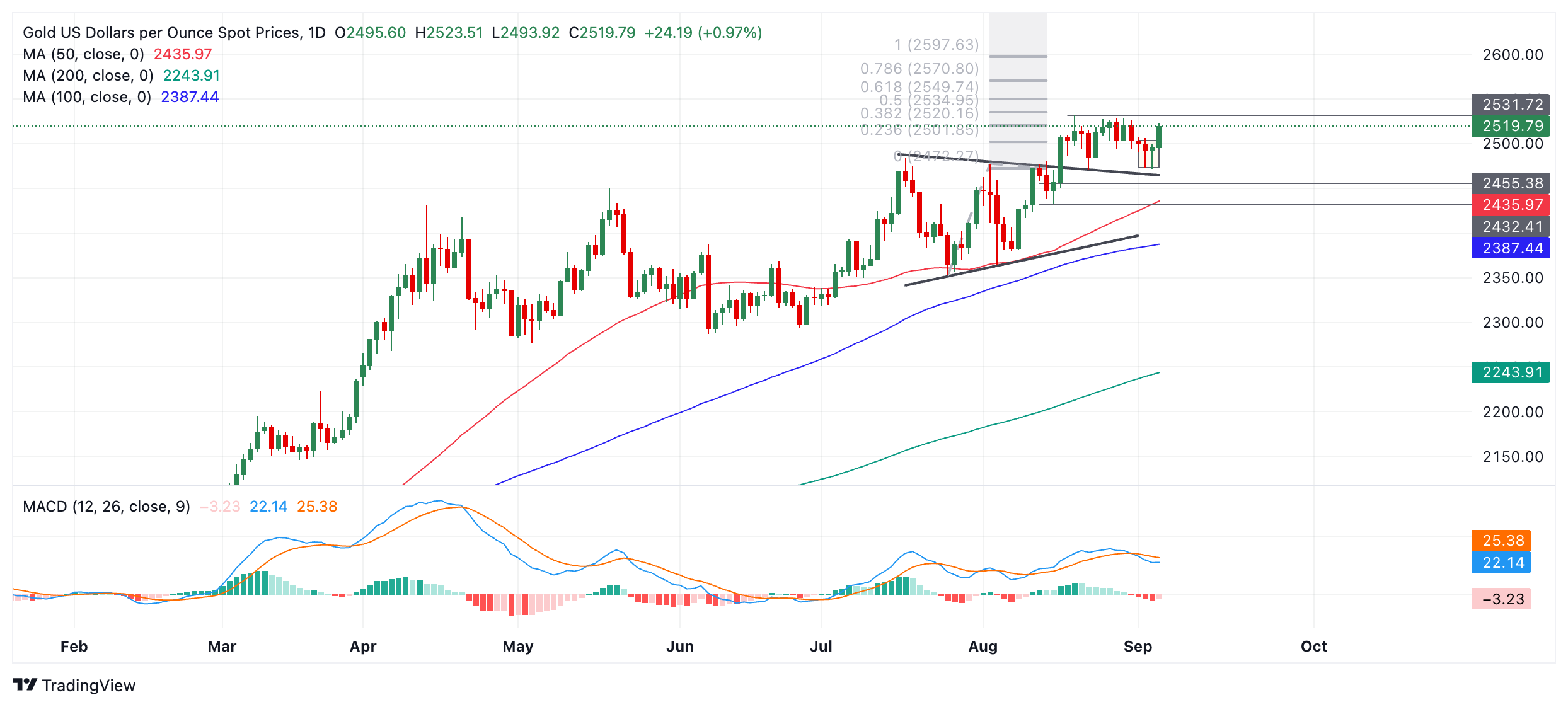- Gold rebounds after the release of under par US job’s data stokes fresh concerns about a hard landing.
- The probability the Fed will cut interest rates by half a percent at its September meeting rises to 45%.
- Technically, Gold forms two bullish Hammer candlesticks in a row, suggesting a chance of a recovery.
Gold (XAU/USD) trades back above $2,500 on Thursday after rebounding from the $2,471 previous day’s lows, following the release of lower-than-expected job openings data in July from the US, which stoked fresh hard-landing fears.
The precious metal is trading back up in the $2,520s during the US session after private payrolls data shows a lower-than-expected number of new hires in August.
ADP Employment Change rose 99K in August from a downwardly-revised 111K in July, and missed expectations of 145K. The data adds to the narrative that the US labor market is vulnerable and the economy could be heading for a hard landing.
Upside for Gold is somewhat tempered, however, by contrasting Jobless Claims data which actually improved on expectations.
Initial Jobless Claims for the week ending August 30 fell to 227K from an upwardlñy-revised 232K when 230K had been expected. Continuing Claims fell to around 1.84M from 1.86M in the previous week when it had been expected to rise to 1.87M.
Gold price finds its feet after job’s data
Gold began its recovery on Wednesday after US JOLTS Job Openings fell to 7.673 million in July from a downwardly revised 7.910 million in June and below estimates of 8.100 million, according to data from the US Bureau of Labor Statistics on Wednesday.
This increased safe-haven demand for the yellow metal and implied interest rates could fall faster than previously anticipated in the US – another positive for Gold, as it reduces the opportunity cost of holding the non-interest-paying asset.
Both the JOLTS and ADP data feeds into the fragile US labor market narrative that is driving Federal Reserve (Fed) interest rate expectations after Fed Chairman Jerome Powell sounded the alarm on jobs in his speech at the Jackson Hole Symposium last month.
It follows weak US manufacturing data on Tuesday, which triggered a global market flash crash that was further exacerbated by fears about the Artificial Intelligence (AI) tech bubble bursting.
From around 31% before the Manufacturing and JOLTS data, the probability of the Fed cutting interest rates by 0.50% at their September 18 meeting, rather than the standard 0.25%, has risen to 45%.
Central Bank buying recovers in July
Gold may also be rising after the World Gold Council (WGC) published data showing a rise in central bank Gold buying. Central bank Gold reserves in July rose by 37.6 tonnes, from -4.6 tonnes in June, according to data from the WGC report released on Tuesday. Central banks have become a major source of Gold demand in recent years and now account for roughly 18% of the market. The data did, however, also show that the People's Bank of China (PBoC) continued its halt on Gold buying in July after stopping purchases in May.
On the geopolitical front, Reuters reports that US negotiators are preparing another ceasefire deal in Gaza whilst the war in Ukraine continues unabated.
Technical Analysis: Two Hammer candlesticks in a row could signal recovery
Gold (XAU/USD) posts two bullish-looking Japanese Hammer candlesticks in a row (box on the chart below), and if Thursday closes as a solid green-up day, that would confirm a possible resumption of the broader uptrend.
XAU/USD Daily Chart
The yellow metal’s price looks poised to rebound to the $2,531 all-time high if it can keep up the bullish recovery momentum.
An upside target for Gold, which has not yet been reached, sits at $2,550 and remains active. The target was generated after the original breakout from the July-August range on August 14.
Gold’s medium and long-term trends also remain bullish, which, given “the trend is your friend,” means the odds still favor an eventual breakout higher materializing.
A break above the August 20 all-time high of $2,531 would provide more confirmation of a continuation higher toward the $2,550 target.
If Gold continues steadily weakening, however, it is likely to find the next support in the $2,470-$2,460 region. A decisive break below that level would change the picture for Gold and suggest that the commodity might be starting a more pronounced downtrend.
Fed FAQs
Monetary policy in the US is shaped by the Federal Reserve (Fed). The Fed has two mandates: to achieve price stability and foster full employment. Its primary tool to achieve these goals is by adjusting interest rates. When prices are rising too quickly and inflation is above the Fed’s 2% target, it raises interest rates, increasing borrowing costs throughout the economy. This results in a stronger US Dollar (USD) as it makes the US a more attractive place for international investors to park their money. When inflation falls below 2% or the Unemployment Rate is too high, the Fed may lower interest rates to encourage borrowing, which weighs on the Greenback.
The Federal Reserve (Fed) holds eight policy meetings a year, where the Federal Open Market Committee (FOMC) assesses economic conditions and makes monetary policy decisions. The FOMC is attended by twelve Fed officials – the seven members of the Board of Governors, the president of the Federal Reserve Bank of New York, and four of the remaining eleven regional Reserve Bank presidents, who serve one-year terms on a rotating basis.
In extreme situations, the Federal Reserve may resort to a policy named Quantitative Easing (QE). QE is the process by which the Fed substantially increases the flow of credit in a stuck financial system. It is a non-standard policy measure used during crises or when inflation is extremely low. It was the Fed’s weapon of choice during the Great Financial Crisis in 2008. It involves the Fed printing more Dollars and using them to buy high grade bonds from financial institutions. QE usually weakens the US Dollar.
Quantitative tightening (QT) is the reverse process of QE, whereby the Federal Reserve stops buying bonds from financial institutions and does not reinvest the principal from the bonds it holds maturing, to purchase new bonds. It is usually positive for the value of the US Dollar.
Information on these pages contains forward-looking statements that involve risks and uncertainties. Markets and instruments profiled on this page are for informational purposes only and should not in any way come across as a recommendation to buy or sell in these assets. You should do your own thorough research before making any investment decisions. FXStreet does not in any way guarantee that this information is free from mistakes, errors, or material misstatements. It also does not guarantee that this information is of a timely nature. Investing in Open Markets involves a great deal of risk, including the loss of all or a portion of your investment, as well as emotional distress. All risks, losses and costs associated with investing, including total loss of principal, are your responsibility. The views and opinions expressed in this article are those of the authors and do not necessarily reflect the official policy or position of FXStreet nor its advertisers. The author will not be held responsible for information that is found at the end of links posted on this page.
If not otherwise explicitly mentioned in the body of the article, at the time of writing, the author has no position in any stock mentioned in this article and no business relationship with any company mentioned. The author has not received compensation for writing this article, other than from FXStreet.
FXStreet and the author do not provide personalized recommendations. The author makes no representations as to the accuracy, completeness, or suitability of this information. FXStreet and the author will not be liable for any errors, omissions or any losses, injuries or damages arising from this information and its display or use. Errors and omissions excepted.
The author and FXStreet are not registered investment advisors and nothing in this article is intended to be investment advice.
Recommended content
Editors’ Picks

AUD/USD: Strong resistance lies at 0.6300
The marked sell-off in the US Dollar allowed AUD/USD to regain strong upside traction and reach multi-day highs in the area just below the key 0.6300 barrier at the beginning of the week.

EUR/USD: Bulls need to clear 1.0400 on a convincing fashion
In line with the rest of the risk-associated complex, EUR/USD managed to regain marked buying pressure and flirted with the area of three-week highs around 1.0430 on Monday.

Gold remains focused on all-time highs
Gold stays in positive territory above $2,700 on Monday as the improving risk mood makes it difficult for the US Dollar to find demand. Markets await US President Donald Trump's speech at the inauguration ceremony.

Solana Price Forecast: Are US traders dumping Bitcoin and XRP for SOL?
Solana (SOL) price stabilized near the $250 support level on Monday, having declined 10% from its all-time high over the last 24 hours.

GBP/USD stays defensive below 1.2200, awaits Trump 2.0
GBP/USD struggles to gain traction and trades slightly below 1.2200 in the second half of the day on Monday. Markets' nervousness ahead of US President-elect Donald Trump's inauguration drag the pair lower despite a broadly weaker US Dollar.

Trusted Broker Reviews for Smarter Trading
VERIFIED Discover in-depth reviews of reliable brokers. Compare features like spreads, leverage, and platforms. Find the perfect fit for your trading style, from CFDs to Forex pairs like EUR/USD and Gold.
